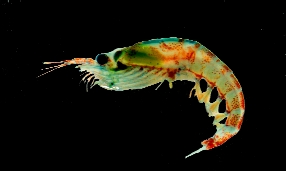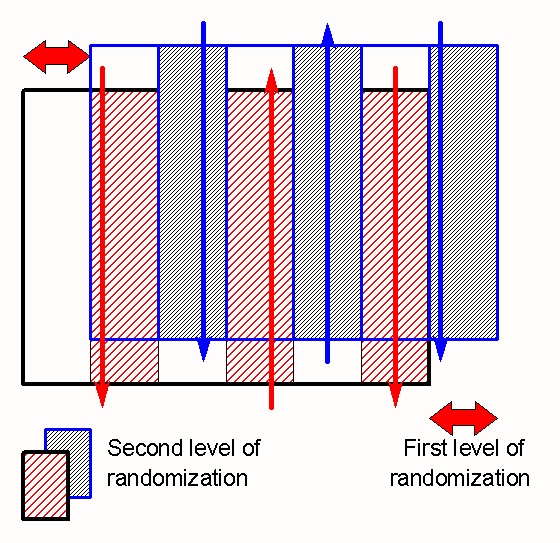 |
The CCAMLR krill synoptic survey |
 |
The CCAMLR krill synoptic survey |
 The synoptic
survey will be a stratified, randomized parallel transect survey design.
The advantage of using such a design is that it will be possible to use
both classical design-based statistical analyses (Jolly
and Hampton 1990) and model-based geostatistical analyses (Petitgas
1993, Murray 1996). The basic
requirement for a randomized survey is that any possible parallel transect
line in the survey area shall have an equal probability of being
sampled. However, one problem with such a design is that if transect positions
are chosen completely at random then it is possible for two adjacent transects
to be very close to each other. To overcome this we suggest a two-stage
randomization. Such a procedure has been used in previous surveys (see
Brierley
et al 1997) and the basic principles are shown in the diagram. The
survey grid (black box) is split into a series of vertical zones; two zones
for each transect in the grid. A transect is randomly placed within alternate
zones (the vertical red arrows within the red-shaded zones). The white
zones contain no transects and so act to keep transects a minimum distance
apart. To comply with the requirement that any transect has an equal probability
of being chosen, the location of the entire survey grid can be moved horizontally
by the width of the white zone. The actual distance is chosen at random.
The effect of moving the survey grid can be seen in the blue grid, where
the blue transects are placed at random within the grey shaded zones.
The synoptic
survey will be a stratified, randomized parallel transect survey design.
The advantage of using such a design is that it will be possible to use
both classical design-based statistical analyses (Jolly
and Hampton 1990) and model-based geostatistical analyses (Petitgas
1993, Murray 1996). The basic
requirement for a randomized survey is that any possible parallel transect
line in the survey area shall have an equal probability of being
sampled. However, one problem with such a design is that if transect positions
are chosen completely at random then it is possible for two adjacent transects
to be very close to each other. To overcome this we suggest a two-stage
randomization. Such a procedure has been used in previous surveys (see
Brierley
et al 1997) and the basic principles are shown in the diagram. The
survey grid (black box) is split into a series of vertical zones; two zones
for each transect in the grid. A transect is randomly placed within alternate
zones (the vertical red arrows within the red-shaded zones). The white
zones contain no transects and so act to keep transects a minimum distance
apart. To comply with the requirement that any transect has an equal probability
of being chosen, the location of the entire survey grid can be moved horizontally
by the width of the white zone. The actual distance is chosen at random.
The effect of moving the survey grid can be seen in the blue grid, where
the blue transects are placed at random within the grey shaded zones.
| Introduction | Itinerary | Station positions | Cruise tracks | Planning Meeting | Sampling Protocols | Participants | Background papers | Contents |
Page last updated on 18 February 1999